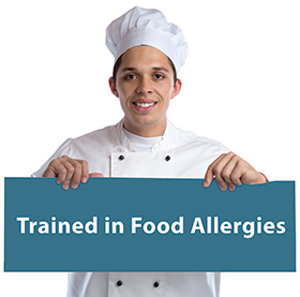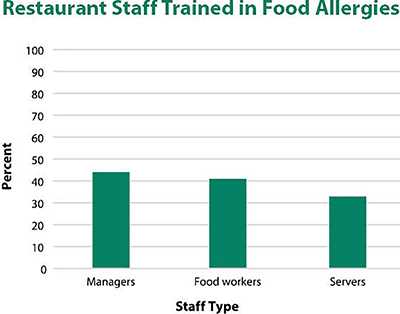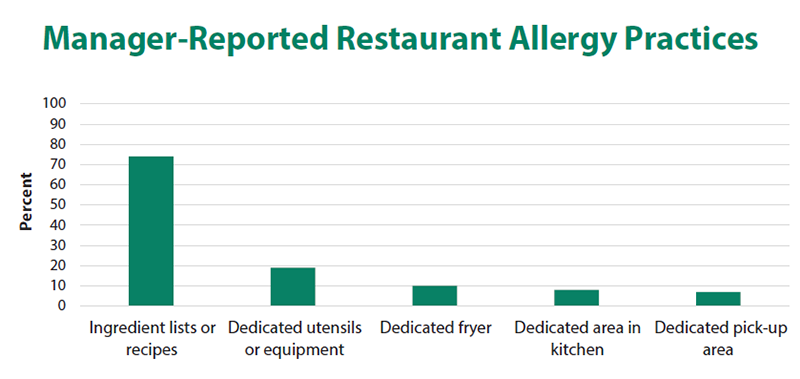How Restaurants Address Food Allergies
This page shows the study purpose, method, results, conclusions, and recommendations in plain language for the EHS-Net project titled Food Allergens Study.
The findings and recommendations from this project are also in fact sheet format [PDF - 223 KB].
Citations for more EHS-Net publications are available by Study Topic or by Citation.
Key Findings & Recommendations
Most restaurants could do more to reduce the risk of food allergic reactions.
- Less than half of interviewed restaurant staff had received training on food allergies. And training often didn’t cover important information such as what to do if a customer has an allergic reaction.
- Most restaurants did not have dedicated areas and equipment for preparing and cooking allergen-free food.
Most restaurants did have ingredient lists or recipes for some or all of their menu items. Ingredient lists and recipes are important tools in reducing the risk of food allergic reactions. Customers with food allergies rely on restaurant staff to provide them with accurate information on ingredients.
We recommend that restaurants
- Provide food allergy training for staff.
- Use dedicated equipment and areas for preparing and cooking meals for customers with food allergies. When this is not feasible, restaurants can clean equipment and workspaces before preparing meals for customers with allergies, according to the Food and Drug Administration’s Food Code guidance.
- Have ingredient lists or recipes for menu items available if they aren’t already.
These practices can help reduce the risk of an allergic reaction.
Study Problem
Food allergies are a growing public health issue:
- About 15 million Americans have food allergies.
- Food allergic reactions are responsible for about 30,000 emergency room visits and 150-200 deaths a year.
Many food allergic reactions occur in restaurants—one in three people with food allergies have had a reaction in a restaurant. Understanding how restaurants address food allergies can help to reduce the risk of food allergic reactions in restaurants.

Study Purpose
The purpose of this study was to find out how many restaurants
- Train their staff on food allergies.
- Have ingredient lists and special equipment and areas for making food for customers with food allergies.
Study Method
Participants
EHS-Net environmental health specialists collected data in about 50 randomly selected restaurants in each of the EHS-Net sites (California, Minnesota, New York State, New York City, Rhode Island, and Tennessee).
Data Collection
Data were collected in 278 restaurants. In each restaurant, data collectors interviewed a manager. In three of four study restaurants, data collectors also interviewed a food worker. In about half of study restaurants, they also interviewed a server.
Study Results
Less than half of interviewed restaurant staff had been trained on food allergies.
In 4 of 5 restaurants, food allergy training covered
- How to prevent cross-contact.
- The major food allergens.
- What to do if a customer has a food allergy.
In 3 of 5 restaurants, food allergy training covered
- Symptoms of an allergic reaction.
- What to do if someone has an allergic reaction.
Most restaurants had ingredient lists or recipes for some or all menu items. But few restaurants had dedicated equipment and areas for preparing and cooking allergen-free food.

Study Conclusions
Most restaurants could do more to reduce the risk of food allergic reactions.
- Less than half of interviewed restaurant staff had received training on food allergies. And training often didn’t cover important information such as what to do if a customer has an allergic reaction.
- Most restaurants did not have dedicated areas and equipment for preparing and cooking allergen-free food.
Most restaurants did have ingredient lists or recipes for some or all of their menu items. Ingredient lists and recipes are important tools in reducing the risk of food allergic reactions. Customers with food allergies rely on restaurant staff to provide them with accurate information on ingredients.
Key Terms
- Environmental health specialists: public health workers who enforce health and safety standards related to food and other consumer products.
- Food allergy: an immune system response that occurs soon after eating a certain food. A reaction can be severe and life threatening.
- Page last reviewed: April 18, 2017
- Page last updated: April 18, 2017
- Content source:


 ShareCompartir
ShareCompartir